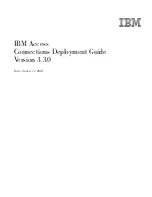
32
4.1.11.4
MIDI Beat Synchronization
You may synchronize the Internal Clock (IC) (see section 4.13), to the MIDI Beat Clock (MBC) by specifying the
number of MBC pulses per IC transition. As a reference, there are 24 MBC pulses per quarter note.
The keyboard LFO (see section 4.14.1) may also be synchronized to incoming the MBC, independently of the Internal
Clock.
Setting different sync counts for these is a fun way to program complex rhythms that are locked to the tempo of
your MIDI tracks.
In order for the MBC messages to be sent to the TimewARP 2600, you must enable MIDI Beat Clock in the Pro Tools
MIDI Menu, and select the TimewARP 2600 as a recipient of these messages. Also, MBC messages are only sent
when the Pro Tools transport control is running.
MBC synchronization is a patch attribute, not a global one; the sync counts you set here will be stored with the
current patch when you save it.
4.1.12
Jacks, Patchcords, and Default Connections
The panel has eighty-one mini-jacks. Forty-five are inputs, twenty-nine are outputs, and 7 operate as both input
and output.
Of the 45 inputs, 32 are in a row running across the center of the panel. (There are actually 34 jacks in the row,
but the two labeled “gate” and “trig” are outputs.) This row of input jacks divides the control surface almost evenly
in half.
Above this row, in the upper half of the control surface, there are only three input jacks. They are at the upper right
corner, labeled Left Input, Pan, and Right Input respectively. All of the other jacks in the upper half of the control
surface are outputs.
In the lower half of the control surface, the jacks numbered 1 through 7 are inputs to the voltage processors, and
of the column of four jacks in the section labeled Sample & Hold, the upper and lower jacks are inputs.
The seven jacks that are both input and output, belong to the Electronic Switch and the Multiple outlet. Because the
switch works in either direction, it has either two inputs and one output or one input and two outputs. The Multiple
output distributes at least one input to 1, 2, or 3 outputs.
All the remaining jacks are outputs. Most of them are labeled as such; a few are not, but have arrows pointing
to them. For example, in the Voltage Processor (VP), the three jacks furthest to the right are outputs; and in the
Envelope Generator section of the upper half of the panel, the two jacks labeled Gate and Trigger are outputs.
4.1.13
Sliders and Slider Operations
There are fifty-eight sliders. Thirty-six of these are plain old signal attenuators. And of those 36, 29 are all in a
row across the middle of the panel. (There are actually 31 sliders in the row, but the two on either side of the box
labeled Attack Release are not plain old signal attenuators.)
Most of the attenuators are directly associated with either an input to something or an output from something.
Each vertical attenuator across the middle of the panel, for example, adjusts the strength of the signal coming in
from the input directly below it.
















































